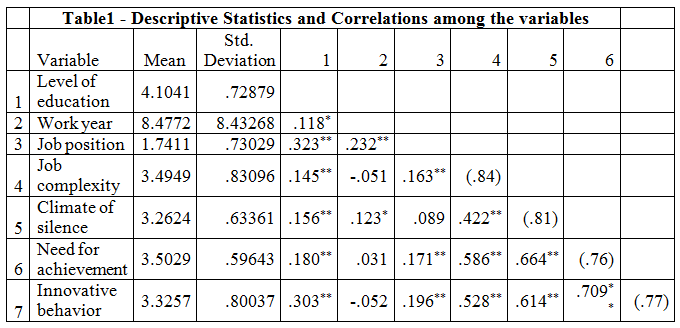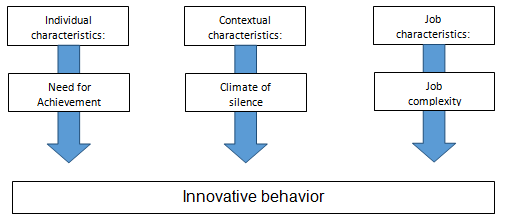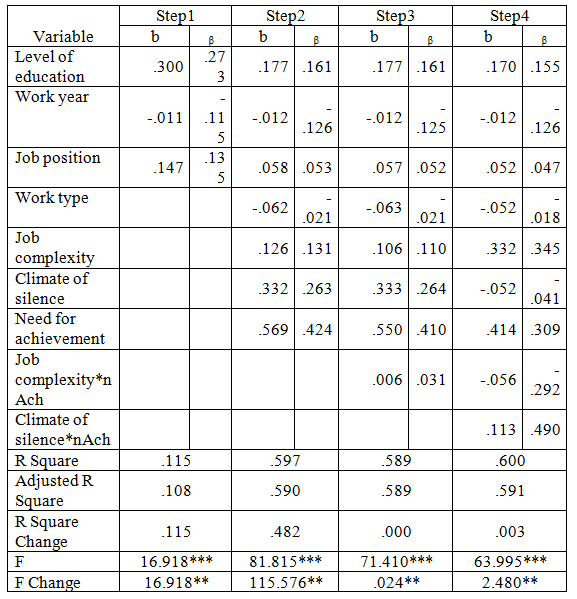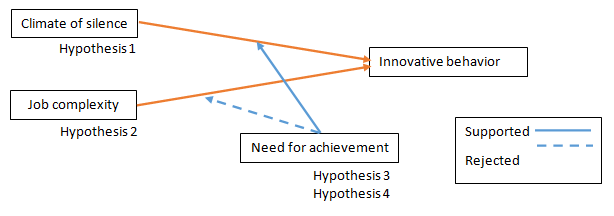THE EFFECTS OF SOME FACTORS ON THE INNOVATIVE BEHAVIOR
Энх-Отгон Д.1, Болор Б.2
1 Кандидат бизнес управления, 2 Кандидат экономических наук, Монгольский государственный университет, Институт бизнеса
ВЛИЯНИЕ НЕКОТОРЫХ ФАКТОРОВ НА ИННОВАЦИОННОЕ ПОВЕДЕНИЕ
Аннотация
Цель этой работы - описать влияние мотивации достижения, которая смягчает климат молчания и факторы сложности рабочих задач, связанные с инновационным поведением. В работе принимается количественный подход. После анализа конструктивной достоверности и надежности выдвинутых гипотез осуществляется их эмпирическая проверка при помощи иерархического регрессионного анализа данных, полученных от 394 лиц.
Ключевые слова: инновационное поведение, мотивация достижения, климат молчания, сложность работы
Enkh-Otgon D.1, Bolor B.2
1 PhD in Business Administration, Associate professor, 2 PhD in Economics, Associate professor, Business School, National University of Mongolia
THE EFFECTS OF SOME FACTORS ON THE INNOVATIVE BEHAVIOR
Abstract
The aim of this paper is to describe the impact of the need for achievement that moderates the climate of silence and job complexity factors involved in innovative behavior. The paper adopts a quantitative approach. After analyzing construct validity and reliability, the study empirically tests its hypotheses by performing a hierarchical regression analysis with a sample of 394 individuals.
Keywords: Innovative behavior, Need for achievement, Climate of silence, and Job complexity
I. Introduction
Today's world is rapidly changing, and this rapid change is demanding that companies and their employees need to adapt to new opportunities and continuously improve their work. Innovation and its behavior have been considered critical to organizational effectiveness and survival. George & Zhou (2001) have demonstrated that, although the ability to innovate and sustain competitive advantage is dependent on many factors, nurturing employees’ innovative behavior is essential for this process. Thus, fostering innovative behavior is the principal role of an organization, and it is perhaps the most important strategy in order to ensure successful operation of a company.
As mentioned <Figure 1>, we selected several factors for study to improve innovative behavior: need for achievement, climate of silence, and job complexity.
Fig. 1 - The factors needing additional study on innovative behavior.
Highly complexity jobs require that employees collaboratively share their knowledge and skills with their co-workers and fully use their knowledge, skills, and abilities, and continuously learn about new technologies and procedures (Kozlowski & Hults 1986). Thus, job complexity can play an important role in innovative behavior.
Morrison & Milliken (2000) noted that the climate of silence is related to organizational silence, and these factors eventually directly influence organizational decision making. Actually, we did not find any study on a direct relationship between climate of silence and innovative behavior. Thus, maybe climate of silence can negatively influence innovative behavior. The factors involved in the improvement of innovative behavior, whether they have a negative or positive influence, are both crucial to increasing organizational success and innovation.
II. Theories and hypotheses
2.1 Climate of silence
Employee’s voice can be defined as the expression of ideas, information, opinions or concerns while silence can be defined as withholding those (Brinsfield et al., 2009). Also, their results indicate that employee’s silence is pervasive, multi-dimensional, can reliably be measured, and is significantly related to other important organizational behavior phenomena. This study’s results expressed that climate of silence can be related to innovative behavior.
Therefore, this study was set to climate of silence negatively effects on the innovative behavior factors were overlooked in previous studies, and set the following hypothesis.
Hypothesis 1: Silence of climate will be negatively related with innovative behavior.
2.2 Job complexity
Michael Tahlin (2011) defined that job complexity, the skill requirements of a job’s work tasks, is the primary dimension of the work activities carried out each day by individuals in work organizations around the world. Zacher & Frese (2009) found that the employees in high job complexity, they should be more likely than the employees in low job complexity to expect that their work will continue to provide them with many work related opportunities in the future. That is why employees in high job complexity interest innovative things for their good future.
It can be seen that the job complexity is important direct factor on creativity and self-efficacy. This result may be referred to indirectly indicate that the job complexity can be a factor that plays an important role in innovative behavior.
Hypothesis 2: Job complexity will be positively related with innovative behavior.
2.3 Need for achievement
In the empirical study of Mumford (2000), people with high need for achievement have strong tendency for the work and they keen to find a new task needs doing to achieve more than low need for achievement people. It means that who has a high potential for innovative behavior characteristics rather than maintaining the low need for achievement, because of their doing and creative thinking to solve the problem. Thus, previous research results show that need for achievement relate to innovative behavior. Baumann & Scheffer (2011) noted that the need for achievement characteristic is an individual’s desire for significant accomplishment of organizational activities. According to definition, need for achievement refer to the need to do something better or faster, accomplish a difficult task, overcome obstacles, or to prove employee’s talent. Thus, we are expecting that need for achievement motives independent variables of climate of silence, and job complexity to increase individual innovate behavior.
The following hypotheses are set based from these studies.
Hypothesis 3: The relationship between climate of silence and innovative behavior is moderated by need for achievement, such that the relationship is positive with high need for achievement and weaker with low need for achievement.
Hypothesis 4: The relationship between job complexity and innovative behavior is moderated by need for achievement, such that the relationship is positive with high need for achievement and weaker with low need for achievement.
III. Empirical analysis
One purpose of this study was to investigate the impact of employees’ innovative behavior characteristics in the case of targeted companies of Mongolia. We distributed 520 questionnaires through e-mail to the selected Mongolian companies from the areas of commercial, manufacturing, services and R&D. In total, 405 questionnaires were completed and collected back and out of that, we excluded some insincere responses and used 394 responses in the analysis.
Measures
To measure the constructs of interest, we used five scales in this study. Those are measures for the dependent variable (innovative behavior) the independent variables (climate of silence and job complexity) and the moderator (need for achievement).
The six measured items of innovative behavior used in this study were developed by Scott & Bruce’s (1994). In general, Scott & Bruce’s (1994) proposed development concept of individual level innovation has been evaluated as the best concept of the innovative behavior.
In order to measure climate of silence, Vakola & Bouradas (2005) developed fifteen questions. The Likert type scale (with five response options) ranging of climate of silence items had an opposite meaning. It means getting answers according to the scale (with five response options) ranging from strongly disagree to strongly agree was not so suitable to demonstrate if there is climate of silence in the organizations.
To measure the job complexity and its indicators within organization, we used four items were developed by Maynard & Hakel (1997). Typically more number of idea are proposed from the people who are responsible for a job with higher job complexity index, which means that the complexity of task or job promotes the process of creative thinking.
According to the Job Characteristics Model of Hackman & Oldham (1980), job characteristics are key things for the level growth needs, and the model explained the moderating effect of the needs on the relationship between employees' job performance and organizational psychology. Thus a study was conducted to prove the above explanation that the needs for achievement is a moderator for individuals desire to constantly perform well and to overcome any difficult obstacles as quickly as possible. We used Steers & Braunstein (1976)’s measurement tools of five short questions about need for achievement, which used McClelland’s achievement motive theory’s questionnaire (Manifest Need Questionnaire) to develop that.
IV. Results
Table1 - displays means, standard deviations, and correlations among all variables.
 Note: Cronbach alphas are reported on the diagonal between brackets. ** P<0.01 : * P<0.05
Note: Cronbach alphas are reported on the diagonal between brackets. ** P<0.01 : * P<0.05
Table 2 - Multiple regression analysis of the independent variables and the innovative behavior
Dependent Variable: Innovative behavior
The regression coefficient of climate of silence and Innovative behavior is 0.310 which is significant (p<0.001) and indicating that climate of silence is positively related to innovative behavior. But as mentioned in multiple regression analysis, climate of silence has a positive relationship with innovative behavior in this regression analysis means that climate of silence is negatively related with innovative behavior. Thus, hypothesis 1 is supported.
The regression coefficient of Job complexity and Innovative behavior is 0.153 which is significant (p<0.001) and indicating that Job complexity is positively related to innovative behavior. Thus, hypothesis 2 is supported.
Table 3 - Hierarchical regression analysis
*** P<0.001 : ** P<0.01
The climate of silence and the moderate variable (need for achievement) on the innovative behavior were significantly affected (F=63.99***, P<0.001, ΔR2=0.003, ΔF=2.48**). This significant affection of climate of silence and moderate variable of need for achievement on the innovative behavior expresses the relationship is positive with high need for achievement and weaker with low need for achievement. Thus, hypothesis 3 is supported.
According to hierarchical regression analysis, the job complexity and moderate variable of need for achievement on the innovative behavior were not affected (F=71.41***, P<0.001, ΔR2=-0.000, ΔF=0.024**). Being no any significant affection of job complexity and moderate variable of need for achievement on the innovative behavior expresses the relationship is negative with high need for achievement and weaker with low need for achievement. Thus, hypothesis 4 is rejected
Fig. 2 - Hypothesis testing results
V. Discussion and conclusion
The study examined needs for achievement as a moderator in the relationships between climate of silence, job complexity and innovation behavior. Climate of silence was negatively related to innovative behavior as hypothesized. And prior results point towards a negative effect of climate of silence (climate of silence negatively effects in organizational commitment) with academic performance (Vakola & Bouradas 2005), we found such effect for innovative behavior in our results. Job complexity was positively related to innovative behavior as hypothesized. According to Michael Tahlin (2011) and our studies, job complexity can be one of the factors which is positively related to innovative behavior by alone. However, more pressure of job complexity with another thing might be disturbed positive relation to innovative behavior. Because we examined that the relationship between job complexity and innovative behavior is moderated by need for achievement, such that the relationship is positive with high need for achievement and weaker with low need for achievement. This hypothesis was rejected, and there was no significant affection. We hope this study provides guidelines to help managers better understand how to increase innovative behavior, and make better decisions about the outcomes and procedures for their employees. The findings of the present study have implications for organizations that are attempting to increase innovative behavior through climate of silence, job complexity, and need for achievement.
References
- Brinsfield, C.T, Edwards, M.E & Greenberg, J. ”Voice and Silence in Organizations: Historical Review and Current Conceptualizations”, Emerald Group Publishing Limited, pp.3-33. 2009.
- Kozlowski, S. W. J., & Hults, B. M. Joint moderation of the relation between task complexity and job performance for engineers. Journal of Applied Psychology, 71, 196–202. 1986.
- Morrison, E. W., & Milliken, F. J. “Organizational silence: A barrier to change and development in a pluralistic world“. Academy of Management Review, 25: 706-31. 2000.
- Zhou, J. & J.M. George When job dissatisfaction leads to creativity: Encouraging the expression of voice, Academy of Management Journal, 44, 682-696. 2001.
- Baumann, N., & Scheffer, D. Seeking flow in the achievement domain: The achievement flow motive behind flow experience. Motivation and Emotion, 35, 267–284. 2011.
- Maynard, D.C., & Hakel, M.D. Effects of objective and subjective task complexity on performance. Human Performance, 10(4), 303-330. 1997.
- Michael Tahlin . “Vertical differentiation of work tasks: conceptual and measurement issues”. Empirical Research in Vocational Education and Training, Vol. 3(1), 55–70, 2011.
- Scott, Susanne G., Bruce, “Determinants of innovation behavior: a path model of individual innovation in the workplace” Academy of Management Journal, Vol. 37(3) : 580-607. 1994.
- Steers, R. M., & Braunstein, D. N. A behaviorally-based measure of manifest needs in work settings. Journal of Vocational Behavior, 9, 251-266. 1976.
- M., Bouradas. D. “Antecedents and consequences of organizational silence: An empirical investigation”. Employee Relations, 27, 441-458. 2005.
- Zacher, H., & Frese, M. Remaining time and opportunities at work: Relationships between age, work characteristics, and occupational future time perspective. Psychology and Aging, 24, 487–493. 2009.




